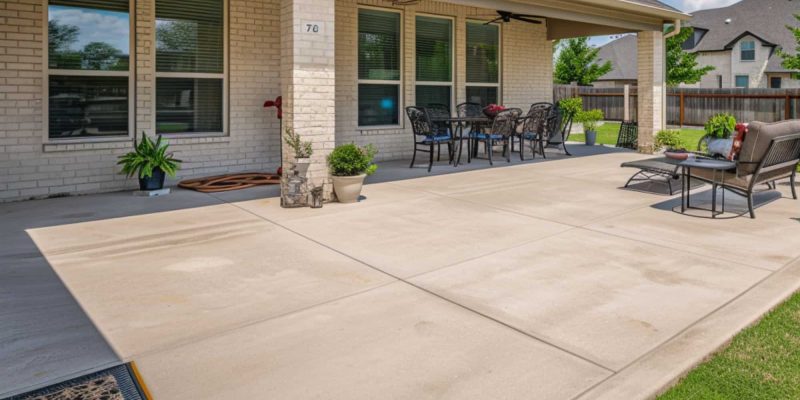Ever looked at your concrete patio and noticed it’s not as clean as it used to be? Stains from oil, rust, and who knows what else can make it look a bit tired. But don’t worry, we’re here to help you get that patio looking sharp again. In this guide, we’ll walk you through how to tackle different kinds of stains and keep your patio in top shape. Let’s dive in and make your patio the pride of the neighborhood again!
Understanding Concrete Patio Stains
Concrete, despite its tough appearance, is a material that’s surprisingly absorbent due to its porous nature. This characteristic makes it susceptible to a variety of stains, each with its own set of challenges for removal. Here’s a closer look at why concrete patios stain easily and the common culprits behind these unsightly marks.
The Porous Nature of Concrete
Concrete is made from a mix of water, cement, sand, and gravel. As it dries and hardens, small holes and air pockets are left throughout the material, creating a surface that’s more like a sponge than a solid block. These pores can absorb liquids quickly, trapping them inside and leading to stains that are not just surface-deep but embedded within the concrete itself.
When something spills on concrete, it doesn’t just sit on the surface; it seeps into these pores, making the stain tougher to clean. The longer the spill remains, the deeper it penetrates, and the harder it becomes to remove. This is why immediate action is crucial for stain prevention on concrete surfaces.
Common Types of Stains
Stains on concrete patios can come from various sources, each requiring a specific approach for effective removal:
- Oil Stains: Commonly from cars, grills, or lawnmowers. Oil can leave dark, slippery spots that are not just unsightly but can also pose a slipping hazard.
- Rust Stains: Caused by metal objects like furniture, tools, or decorative items left on the patio. Rust stains are recognizable by their reddish-brown color and can be particularly stubborn to remove.
- Grease Stains: Similar to oil, grease from cooking or automotive work can spill and settle into concrete, creating dark spots that attract more dirt and debris.
- Organic Stains: Leaves, berries, moss, and algae can leave green, brown, or black stains. These are typically easier to clean but can become permanent if left unaddressed.
NOTE
Understanding the type of stain you’re dealing with is crucial for choosing the right cleaning method. Each stain has its own characteristics, and what works for one may not work for another.
How to Remove Each Type of Concrete Stain
Removing stains from your concrete patio requires understanding the specific approach needed for each type of stain. Here’s a detailed look at how to tackle each one effectively.
Removing Oil Stains
Oil stains are among the most common and challenging to remove. They penetrate deeply into the concrete and can leave a lasting mark if not treated properly.
- Absorb Excess Oil: Before applying any cleaning solution, it’s important to absorb as much of the oil as possible. You can do this by covering the stain with a layer of cat litter, baking soda, or cornstarch. Let it sit overnight, then sweep it up.
- Apply a Degreaser: Choose a commercial concrete degreaser designed for oil stain removal. Apply the degreaser according to the manufacturer’s instructions, usually by pouring it over the stain and letting it sit for a specified time.
- Scrub the Area: Using a stiff nylon brush, scrub the stained area vigorously to help break up the oil. For larger or older stains, a second application of degreaser may be necessary.
- Rinse Thoroughly: Wash away the degreaser and lifted oil with a hose or pressure washer. Ensure the water doesn’t flow into areas where it can cause environmental harm.
Eliminating Rust Stains
Rust stains require a different approach due to their chemical composition. These stains are typically caused by iron or metal objects left on the concrete.
- Lemon Juice and Salt: For a natural solution, sprinkle salt over the rust stain, then squeeze lemon juice on top. The acid in the lemon juice reacts with the rust, helping to lift it from the concrete. Leave the mixture on the stain for about 15 minutes.
- Commercial Rust Remover: For more stubborn stains, a commercial rust remover can be more effective. These products contain chemicals that react with the rust to dissolve it. Follow the manufacturer’s instructions carefully, as these removers can be harsh.
- Scrub and Rinse: Use a scrub brush to work the remover into the stain, then rinse thoroughly with water. It may be necessary to repeat the process for deep stains.
Tackling Grease Stains
Grease stains, similar to oil, can be persistent and require a methodical approach to remove.
- Cover with Absorbent: Sprinkle an absorbent material like baking soda or cornstarch over the grease stain and let it sit for several hours or overnight.
- Scrub with Dish Soap: Mix dish soap with warm water and apply it to the stained area. Dish soap is designed to break down grease and can be effective on concrete stains.
- Hot Water Rinse: After scrubbing, rinse the area with hot water to help dissolve the grease. A pressure washer set to a low pressure can also be effective for rinsing.
Cleaning Organic Stains
Organic stains from leaves, berries, and moss can usually be treated with less aggressive methods.
- Vinegar Solution: Mix equal parts white vinegar and water in a spray bottle. Vinegar is a natural acid that can help break down organic stains without harming the environment.
- Apply and Scrub: Spray the vinegar solution generously over the stained area and let it sit for about 30 minutes. Then, scrub the area with a stiff brush.
- Rinse with Water: Rinse the area thoroughly with a hose or pressure washer to remove the vinegar and lifted stain residue.
Preventive Maintenance for Concrete Patios

To maintain your concrete patio’s appearance and minimize stain removal effort while preventing future patio repairs, regular preventive maintenance is key. Here are detailed strategies to protect your patio from common staining issues:
Regular Cleaning Practices
The first line of defense against patio stains is regular cleaning. This doesn’t have to be a laborious process but incorporating these habits can significantly reduce the risk of stains setting in.
- Weekly Sweeping: Use a push broom to sweep off leaves, dirt, and debris. This simple step prevents organic materials from decomposing on your patio and causing stains.
- Bi-annual Washing: Twice a year, preferably in the spring and fall, give your patio a thorough wash. A garden hose with a spray nozzle is usually sufficient for this task. For tougher grime, a mild detergent mixed with water can be applied and scrubbed with a broom before rinsing.
Sealing the Concrete
Applying a sealer to your concrete patio can significantly extend its lifespan and protect it against stains. Sealers fill in the pores of the concrete, creating a barrier that liquids cannot penetrate.
- Choosing the Right Sealer: There are several types of concrete sealers available, including acrylic, epoxy, and penetrating sealers. For patios, a penetrating sealer is often recommended because it protects the concrete without changing its appearance.
- Application Frequency: Most concrete patios need to be resealed every two to three years, but this can vary based on weather conditions and the amount of foot traffic. Signs that it’s time to reseal include water soaking into the concrete rather than beading on the surface.
Immediate Action on Spills
Spills are inevitable, especially on outdoor patios used for dining and entertaining. How you respond to spills can make a significant difference in whether or not they become stains.
- Quick Cleanup: Blot up spills as soon as they occur, using paper towels or a clean cloth. Avoid wiping, as this can spread the spill.
- Appropriate Cleaning Solutions: For oil or grease spills, apply an absorbent material like kitty litter immediately, then clean the area with a degreaser as soon as possible. For organic spills like wine or berry juice, a mild detergent solution can be applied and rinsed off.
Choosing the Right Cleaning Products
The cleaning products you use can affect both the appearance of your patio and the environment. Opting for eco-friendly options ensures your maintenance routine is as green as possible.
- Eco-Friendly Cleaners: Look for cleaners labeled as eco-friendly or biodegradable. These products are designed to be effective without containing harsh chemicals that can harm your lawn or garden.
- Natural Solutions: Consider using natural cleaning agents like vinegar or baking soda for routine cleaning. These household items are safe for the environment and can be effective for light cleaning tasks.
Advanced Protection Techniques
For homeowners in Waco, Texas, who want to go beyond basic maintenance to ensure their concrete patio remains pristine, here are some advanced techniques to consider. These methods offer additional layers of protection against staining and wear, keeping your outdoor living space looking great for years to come.
Epoxy Coatings for Stain Prevention
Epoxy coatings offer a robust solution for protecting your concrete patio from stains, moisture, and damage. Unlike sealers that penetrate the concrete, epoxy forms a protective surface layer that is resistant to a wide range of substances.
- Benefits of Epoxy: Epoxy coatings are durable, resistant to oil, grease, and many chemicals, and can significantly enhance the appearance of your patio with a variety of finishes and colors available.
- Application Considerations: Applying an epoxy coating is more involved than sealing and typically requires the concrete to be professionally prepared to ensure proper adhesion. The surface must be clean, dry, and free of any previous coatings or sealants. Due to the complexity of the application process and the need for specialized equipment, hiring a professional is recommended.
The Role of Professional Services
Sometimes, the best way to protect your concrete patio is to enlist the help of professionals. Whether it’s for applying an advanced protective coating, performing deep cleaning, or handling difficult stains, professional services can offer expertise and efficiency.
Professional Cleaning
For deep cleaning or stubborn stains that DIY methods can’t address, professional cleaners use commercial-grade products and equipment to restore your patio. They can also advise on specific stain removal techniques tailored to your patio’s condition.
Protective Coatings Application
Professionals can apply sealants, epoxy coatings, or other protective treatments evenly and effectively. They understand how to prepare the surface, choose the right product for your needs, and apply it in a way that ensures lasting protection.
Consultation Services
If you’re unsure about the best way to maintain or protect your patio, consulting with a professional can provide valuable insights for your concrete patio. They can assess the condition of your concrete, recommend maintenance strategies, and suggest protective measures tailored to your patio’s specific challenges.
Conclusion
And there you have it, Waco homeowners—a complete guide to removing stains from your concrete patio and keeping it looking its best. With the tips and techniques we’ve shared, you’re well-equipped to tackle any stains that come your way. Remember, a little bit of regular maintenance goes a long way in keeping your patio beautiful. Happy cleaning, and enjoy your sparkling clean patio!

